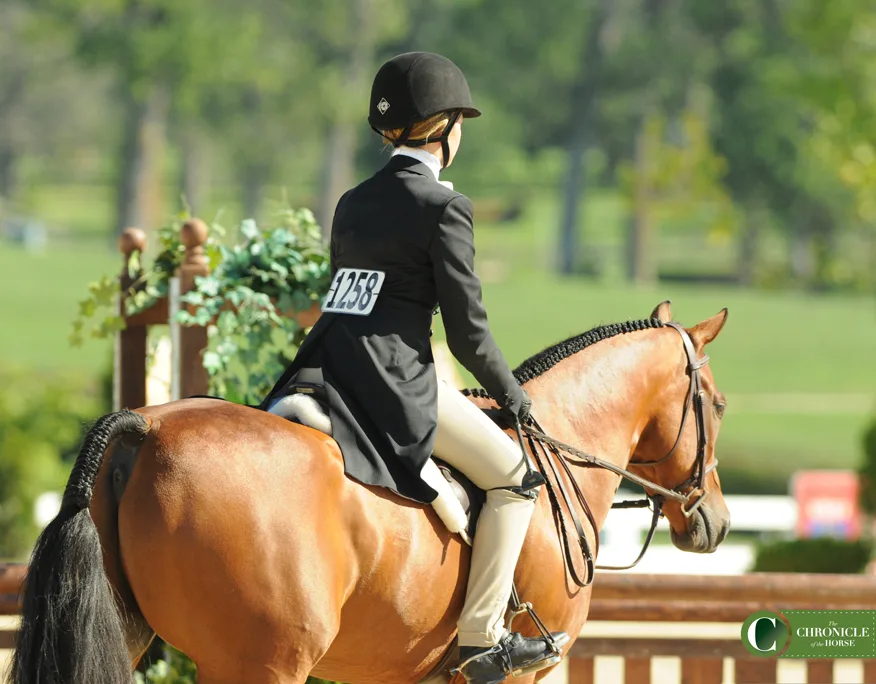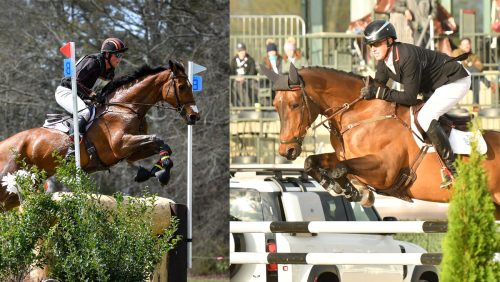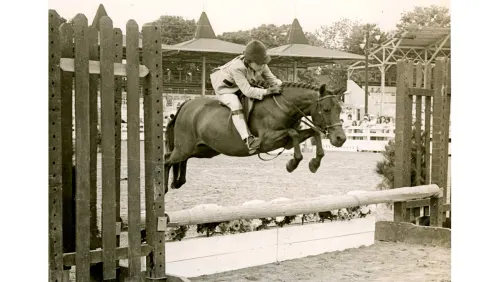You can watch the U.S. Hunter Jumper Association Board of Directors meeting—where the board will make their final votes on each rule change proposal to send to the U.S. Equestrian Federation —live-streamed on COTH TV on Dec. 15 at 8 a.m. to 12 p.m. PST (11 a.m.-3 p.m. EST).
There are more than 70 rules on the docket for discussion at the upcoming U.S. Hunter Jumper Association meeting in Palm Springs, Calif., Dec. 11-15. Most are specific to hunter/jumper shows, but the proposal making the biggest waves affects horses across sports.
The USEF Horse Welfare Initiative Task Force introduced a series of proposed rule changes that aim to ensure horses’ wellbeing, most notably GR 844, which mandates necropsies for all horse fatalities on show grounds, as well as those who die as a result of injury or illness sustained during a show. This would include cases where the animal was euthanized.
Currently there is no necropsy requirement after a horse dies at a competition.
The rule change proposal will only apply when there is a veterinary pathology lab within 200 miles, and the federation will cover the cost of uninsured horses up to $1,000, and will cover half the cost for insured horses up to $500. If the insurance company requires a necropsy the USEF will not pay for it.
The USEF proposal is already generating plenty of chatter. It’s the only rule going forward for discussion at the USHJA meeting where multiple committees have already weighed in, largely to express their disapproval. The American Saddlebred, Andalusian/Lusitano, Arabian, Friesian, National Show Horse, Western and Western Dressage committees have all voted against this rule. They mainly cited cost and emotional concerns. Carriage pleasure driving and Paso Fino committees both recommended approval.
“In requiring a necropsy and having access to the results of necropsies, the federation will be able to gather critical information regarding the horse fatalities that occur at licensed competitions,” states the intent of the rule. “This information would be used primarily to conduct research on the health and safety of horses. This requirement will also lead to the implementation of safety mechanisms that protect the horse and rider at all licensed competitions.”
The Fédération Equestre Internationale requires necropsies for all horses who die at FEI competitions or after a competition, where the death is related to the competition. The FEI also covers the cost of the post-mortem up to €650, around $700.
The U.S. Eventing Association encourages, but does not yet require, necropsies after certain horse falls. The USEA established a fund to pay for necropsies that occur at events if the fatality occurs at a fall at an obstacle or fence and there is reason to suspect that a physical abnormality may have contributed to the fall. To use the fund the owner of the horse must give permission for the necropsy.
A proposed change to GR 839, which outlines what constitutes cruelty and abuse, strengthens that rule, by expanding the rule to also forbid “any evidence of cruel and abusive training techniques” and by holding responsible any person who presents a horse for competition that exhibits signs of cruelty or abuse. In the proposed change a portion of the rule that recommended show committees contact the American Humane Association has been struck out.
The Task Force also introduced a change to GR 843, the so-called “collapse rule,” which clarifies that show management shall be responsible for ensuring that any horse or pony that collapses is subject to drug and medication testing.
Around The Showgrounds
A proposed change to GR309.2 would make USEF penalties and suspensions—aside from safe sport violations—visible only on the member portal section of the USEF website.
There’s a series of proposed rule changes to GR308, the so-called “mileage rule,” proposed by Adrienne Karazissis of West Palms Events, which operates competitions through the FEI World Cup Qualifier-level throughout the west coast.
The proposals seek to decrease certain mileage protections for priority date holders and create a process for a panel to review situations wherein a new license is turned down due to a mileage conflict where the venue distance is less than 15 percent of the required mileage guidelines.
Proposed changes to HU 154 and JP 103.9 would ban the use of cell phones or ear buds in hunter and jumper schooling areas.
A proposed change to GR 1211 would require all competitions to have a Basic Life Support ambulance present on site for all licensed show days.
A proposed change to HJ 208 increases the requirements for exercising and lunging areas at competitions with either more than 500 competitors or at most horse show series.
A proposed change to GR126.2 allows mules to compete in all non-breed restricted competitions.
ADVERTISEMENT
A proposed change to GR 1037.1 prohibits other show committee officers from judging at the horse show.
A proposed change to GR1015 addresses what level of stewards may officiate at which competitions.
A proposed change to GR 812 would allow horses who have been officially retired to show in beginner classes.
Hunter Happenings
A proposed change to HU 191 prohibits credit earned in USHJA International Hunter Derby classes from counting toward USEF Horse of the Year standings for conformation divisions, as the derbies don’t have a conformation component.
A proposed change to GR 837 would rename “certified jumper schooling supervisors” to “certified schooling supervisors” and require a category 1 steward or a certified schooling supervisor in hunter schooling area during any hunter class with $10,000 or more of prize money. Another to HJ 102.9 would require schooling supervisors have appropriate seating and climate protection.
A proposed change to HU 172.1 separates out pony and horse measurement. Ponies would continue to be eligible for a standard card at the age of 8, while horses would return to being eligible for standard cards at 6.
A proposed change to GR 850 would prohibit horses and ponies from showing if they had tail alteration, such as stretching, docking or being surgically altered. Braiding, banging, adding artificial tail hair and trimming the tail are permissible under this rule.
Two proposed changes address the 3’3″ junior hunter divisions. A change to HU 119 would allow USHJA zone championship competitions to hold a 3’3″ junior hunter division without also holding a standard junior hunter division, as many of those competitors are competing on the fall indoor circuit which falls around the same time as many zone finals, and one to HU 111 intends to modify the combining and dividing requirements of the 3’3″ junior hunter division to match that of the standard junior hunter division.
A proposed change to HU 185.5 would limit the number of hunter breeding sections a competition may offer that will count toward USEF Horse of the Year standings.
Proposed changes to GR 1057 and GR 1059.5 would reduce the number of times hunter and equitation judges must attend USEF/USHJA judges’ clinics from two to three years.
Jumper Jabber
A proposed change to JP 122 would create a new grand prix standard in addition to regional, national and high performance standards. The new standard, the “American standard,” would rank between the regional and national standards, with fences at 1.40 to 1.45 meters with spreads to 1.60 meters.
Several possible changes to the young jumper classes will be up for discussion, including JP 116.4, which creates a standard fence height for 5-year-old jumper courses after July 1 and a requirement for a certificate of compliance that all young jumper classes were held at the right specifications. There’s also a rule for discussion allowing jump-offs only for the second half the season for 5-year-old jumper competitors (JP 116.4) and allowing Table II sec. 2 (d) classes for 6-year-old jumper classes. Table II sect. 2d classes are time first jump-off classes with a designated number of competitors to jump off.
A proposed change to JP 147.1 would allow judges to penalize horses 2 seconds for each jumping fault rather than 4 in indoor arenas or smaller rings.
A proposed change to JP 4 limits jumps in the schooling area to be no more than 10 cm. higher or wider than the class in progress.
A proposed change to JP 122.4 defines the conditions in which course designers may vary the height of fences in a national standard or a high performance standard grand prix. According to this rule change they may make the change if there is “deterioration of footing, inclement weather, insufficient lighting or fewer than 10 entries at the time declarations are due.”
A proposed change to JP 131.2 would set the time allowed for competitors in children’s and adult amateur classes at based on a minimum speed of 325 meters per minute. Currently only pony jumpers have a minimum speed of 325 meters/minute and all other jumpers have a minimum speed of 350 meters/minute.
A proposed change to JP 135 prescribes how horses may compete hors de concours, which is currently allowed “at management’s discretion.” The change requires exhibitors to declare their intent to compete hors de concours before the class and prohibits horses that have competed hors de concours from entering a subsequent class in the same ring for prize money.
ADVERTISEMENT
Proposed changes to JP 142.3 and JP 145.3 clarify how many horses return to the jump-off I Table II sec. 2 (e) and (f) classes.
Equitation Efforts
Thomas O’Mara proposed a rule change to EQ 110 that would create a new medal class to expose junior riders to the NCAA equestrian format before college. Four of O’Mara’s children competed successfully in the equitation divisions before heading to college, and his son T.J. O’Mara won both the 2016 Platinum Performance/USEF Talent Search Final (N.J.) and the 2016 Pessoa/USEF Medal Final (Pa.) before heading to the University of Kentucky this fall.
A proposed change to EQ 112.0 would eliminate walk jumps from the USEF equitation tests.
Two proposed changes to EQ 105.5 would prohibit belly bands or bandages anywhere on a horse besides its legs and clarifies the tack requirement for the Washington International Horse Show Equitation Classic Jumper Phase, USHJA Jumping Seat Medal and any other jumping seat equitation class save the USEF Talent Search Medal, which has its own requirements. This change would also make drop nosebands legal.
A proposed change to EQ 110.10 will prevent riders who complete the course in both phases of a two-phase WIHS equitation class from being penalized if not enough riders complete the course in the second phase.
A proposed change to GR 1009 would clarified that “r” rated judges may not officiate alone over specific equitation classes at national- and premier-rated shows, including the ASPCA Maclay, the WIHS and the Platinum Performance/USEF Show Jumping Talent Search Medal, among others.
Proposed changes to EQ 106.8 and GR 808.2 lay out how championships in equitation divisions are to be calculated.
Amateur Amendments
Changes to JP 117.2 and GR1133 would create an amateur jumper division with no ownership requirement at a nationally recognized level with a USEF Horse of the Year award. This would be in addition to the current amateur-owner divisions. There are three proposed height divisions: 1.40 to 1.45 meters; 1.30 to 1.35 meters; and 1.20 to 1.25 meters.
Two proposed changes to GR 1306.3—the so-called “amateur rule”—are on offer. One would explicitly allow grooms who are also amateurs to lunge horses and not be considered professionals, and another would clarify that amateurs may organize, manage and hosts clinics as long as they are not performing the activities of an instructor or trainer.
A proposed change to HU 112 would allow competition management to offer a USHJA National Hunter Derby restricted to juniors and amateurs as well as an open division. It also allows managers to divide any open hunter class into one restricted to juniors and amateurs and one that’s open to all.
A proposed change to JP 117.5 would change how entries in combined junior and amateur-owner jumper classes are split.
A proposed change to GR202 would automatically renew one’s amateur status unless the member notifies the USEF of a change.
Pony Prattle
Proposed changes to EQ103.4 and HU 110 clarify when adults may compete ponies in hunter and equitation classes, and another to JP118 would remove a restriction on adults competing pony jumpers in any other class at the show.
A proposed change to EQ 110.6 allows three entries to fill a U.S. Pony Medal class, though reduced points will be offered when there are three to five entries in any given class.
We’ve summarized the standout rules here. You can see all the U.S. Equestrian Federation rule change proposals that will be discussed at the USHJA annual meeting with comments from the committees that have already discussed it here http://www.ushja.org/programs/rules/rules_proposal.aspx, and with member comments here http://prc.usef.org/portals/ushjaforum.aspx. USEF members may submit comments on the rule changes by logging onto the USEF website.
You can watch the U.S. Hunter Jumper Association final Board of Directors meeting—where the board will make their final votes on each rule change proposal to send to the U.S. Equestrian Federation —live-streamed on COTH TV on Dec. 15 at 8 a.m. to 12 p.m. PST (11 a.m. – 3 p.m. EST).















